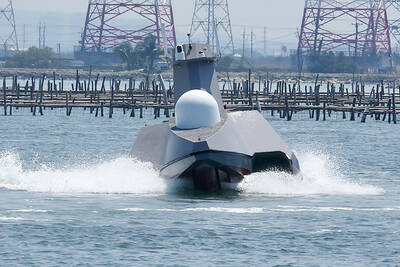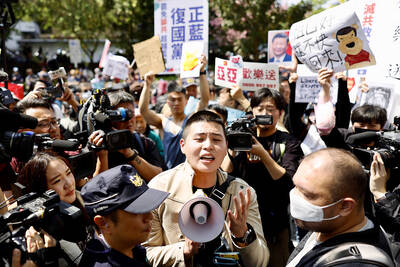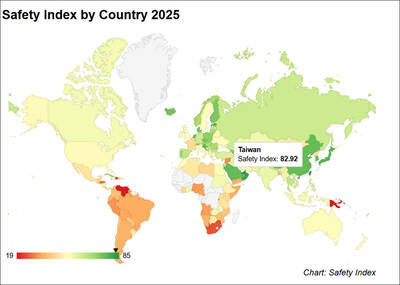China's air force has deployed 12 advanced Jian-10 fighter jets to Zhejiang Province, a news report said yesterday.
"The military is studying why the Chinese military has [recently] been unveiling its development of new weapons in such a high-key fashion, such as the production of J-10 fighter jets and the launching of a ballistic missile to shoot down an orbiting satellite," Ministry of National Defense spokesman Rear Admiral Wu Chi-fang (
"The military wants to know what strategy or goal is behind the posturing," Wu said.
Wu said the military would soon make public information concerning the impact of China's deployment of J-10 fighters.
Chinese state TV last month aired videos that it described as showing that batches of the J-10 fighter -- both the single-seat J-10A and the two-seat J-10B -- had entered operational service.
Footage showed the jets performing aerial maneuvers, including firing air-to-air and air-to-surface missiles.
Wu yesterday did not confirm whether or not the People's Liberation Army Air Force (PLAAF) had deployed J-10 jets in Zhejiang, one of three coastal provinces that abut the Taiwan Strait.
The Chinese-language daily China Times yesterday cited a military source as saying that 12 J-10 jets had been deployed at an air force base around 500km from Taiwan.
The news report said Taiwanese military officials believe that the J-10's combat performance is inferior to that of comparable fighters, such as the Russian-made Su-27 and Su-30 fighters. The PLAAF currently possesses some 400 Su-27s and Su-30s.
Taiwan's air force still sees the Chinese Su-27 and Su-30 fighter jets as the main rivals for Taiwan's advanced fighter aircraft, and uses them as primary targets when conducting computer war games, the newspaper said, without citing a reference.
International military experts believed the PLAAF would produce 300 to 500 J-10 jets, the newspaper said, adding that Taiwan's military intelligence learned China would produce only 120 J-10s, without providing a source.
The newspaper also speculated that the deployment of J-10s would pose a threat to Taiwan's security, and that the new jets would gradually replace PLAAF old J-7 and J-8II fighter jets.
The newspaper said China would send J-8 and J-10 jets force to engage Taiwan's US-made F-16 and French-made Mirage 2000 war planes in the beginning of a cross-strait conflict, before sending its more advanced Russian-made aircraft.
The strategy is to weaken Taiwan's air force through attrition, the news report cited an unnamed military source as saying.
Hong Kong-based defense magazine Kanwa Defense Review Editor-in-Chief Andrei Chang told the state-run Central News Agency earlier this month that China wanted to deter the possibility of instability and tension across the Taiwan Strait this year and next by highlighting its military capabilities.
Chang said, however, that the J-10 jets were no match for late-model F-16s in combat performance, particularly with regard to air-to-surface combat.

ENDEAVOR MANTA: The ship is programmed to automatically return to its designated home port and would self-destruct if seized by another party The Endeavor Manta, Taiwan’s first military-specification uncrewed surface vehicle (USV) tailor-made to operate in the Taiwan Strait in a bid to bolster the nation’s asymmetric combat capabilities made its first appearance at Kaohsiung’s Singda Harbor yesterday. Taking inspiration from Ukraine’s navy, which is using USVs to force Russia’s Black Sea fleet to take shelter within its own ports, CSBC Taiwan (台灣國際造船) established a research and development unit on USVs last year, CSBC chairman Huang Cheng-hung (黃正弘) said. With the exception of the satellite guidance system and the outboard motors — which were purchased from foreign companies that were not affiliated with Chinese-funded

PERMIT REVOKED: The influencer at a news conference said the National Immigration Agency was infringing on human rights and persecuting Chinese spouses Chinese influencer “Yaya in Taiwan” (亞亞在台灣) yesterday evening voluntarily left Taiwan, despite saying yesterday morning that she had “no intention” of leaving after her residence permit was revoked over her comments on Taiwan being “unified” with China by military force. The Ministry of the Interior yesterday had said that it could forcibly deport the influencer at midnight, but was considering taking a more flexible approach and beginning procedures this morning. The influencer, whose given name is Liu Zhenya (劉振亞), departed on a 8:45pm flight from Taipei International Airport (Songshan airport) to Fuzhou, China. Liu held a news conference at the airport at 7pm,

Taiwan was ranked the fourth-safest country in the world with a score of 82.9, trailing only Andorra, the United Arab Emirates and Qatar in Numbeo’s Safety Index by Country report. Taiwan’s score improved by 0.1 points compared with last year’s mid-year report, which had Taiwan fourth with a score of 82.8. However, both scores were lower than in last year’s first review, when Taiwan scored 83.3, and are a long way from when Taiwan was named the second-safest country in the world in 2021, scoring 84.8. Taiwan ranked higher than Singapore in ninth with a score of 77.4 and Japan in 10th with

GRIDLOCK: The National Fire Agency’s Special Search and Rescue team is on standby to travel to the countries to help out with the rescue effort A powerful earthquake rocked Myanmar and neighboring Thailand yesterday, killing at least three people in Bangkok and burying dozens when a high-rise building under construction collapsed. Footage shared on social media from Myanmar’s second-largest city showed widespread destruction, raising fears that many were trapped under the rubble or killed. The magnitude 7.7 earthquake, with an epicenter near Mandalay in Myanmar, struck at midday and was followed by a strong magnitude 6.4 aftershock. The extent of death, injury and destruction — especially in Myanmar, which is embroiled in a civil war and where information is tightly controlled at the best of times —